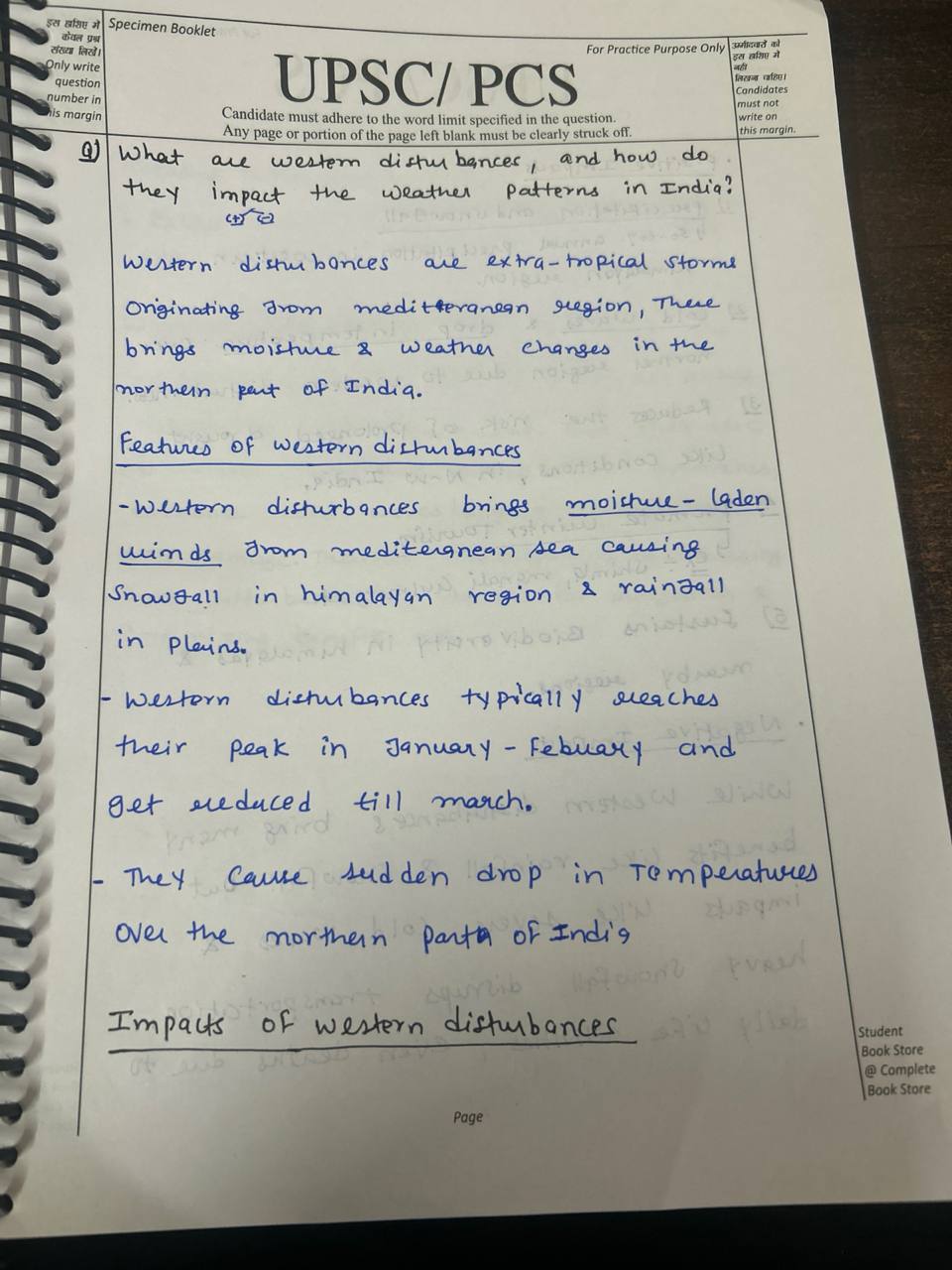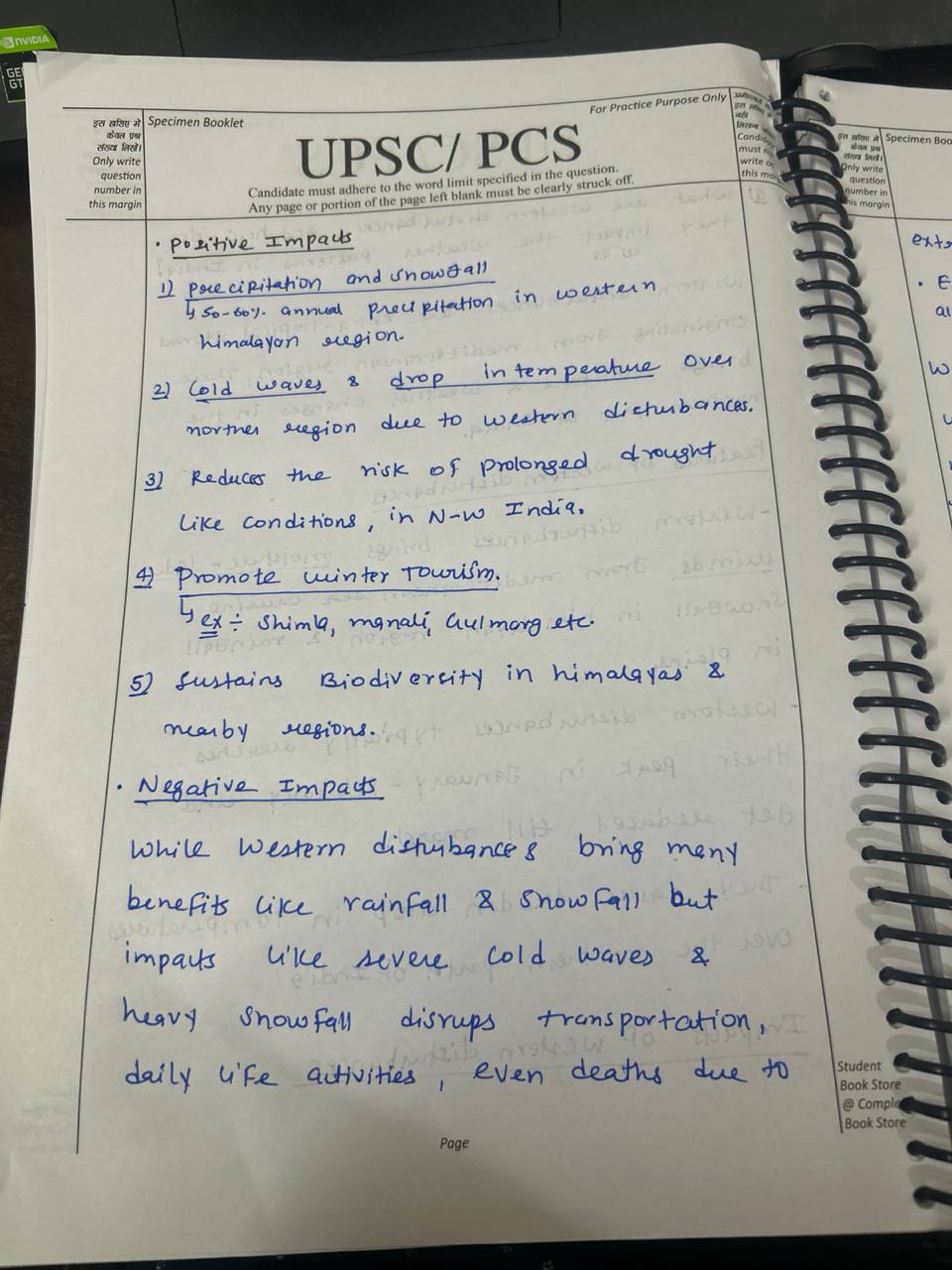Climate
Share
393 Followers
294 Answers
183 Questions
Resources & Suggestions
Mains Answer Writing Latest Articles
On: April 7, 2025
Daily Answer Writing Practice Questions (7 April 2025)
The partnership between the private and public sectors is crucial for the successful development of an investment model for urban infrastructure. Discuss. (Answer in 250 words) शहरी बुनियादी ढांचे से जुड़े निवेश मॉडल के सफल विकास के लिए निजी और ...
On: April 6, 2025
Daily Answer Writing Practice Questions (5 April 2025)
Do you agree that the rediscovery and revival of India’s ancient past and its rich traditions had a mixed effect on the freedom movement? Discuss. (Answer in 250 words) यह तर्क दिया गया है कि भारत के अतीत और उसकी ...
On: April 5, 2025
Daily Answer Writing Practice Questions (5 April 2025)
Examine the evolution of cooperatives in independent India and their role in advancing agricultural development. (Answer in 150 words) स्वतंत्रता के बाद भारत में सहकारी समितियों के विकास और कृषि क्षेत्र में उनके योगदान पर विचार करें। (उत्तर 150 शब्दों ...

Climate change
Climate change is emerging prominently in subcontinental countries such as India and Southeast Asia. Some of the most important expressions are as follows: -Heightened Heatwaves: More frequent and intense heatwaves are posing a significant problem. These are causing increased mortality, heat stressRead more
Climate change is emerging prominently in subcontinental countries such as India and Southeast Asia. Some of the most important expressions are as follows:
-Heightened Heatwaves: More frequent and intense heatwaves are posing a significant problem. These are causing increased mortality, heat stress illnesses, and reduced agricultural productivity.
This shifts the rainfall trend and leads to both droughts and extreme flooding elsewhere, disrupting agriculture, destroying infrastructure, and probably leading to water scarcity and heightened vulnerability to waterborne diseases.
This is associated with sea level rise as, along coastlines, sea levels have risen; this leads to increased coastal erosion, saltwater intrusion into sources of fresh, and communities have been displaced from the coastline.
-Glacier Melt: Glacier melting in the Himalayas and other mountain ranges is impacting the availability of water for millions downstream. This has implications for both water scarcity in dry seasons and increased flood risk in wet seasons.
-Increasing Extreme Weather Events: More frequent and intense cyclones, typhoons, and other extreme weather events have caused widespread destruction to infrastructure, livelihoods, and ecosystems.
Changes in temperature and rainfall patterns have an impact on crop yields, leading to food insecurity and economic losses for farmers.
See lessThe impacts are not evenly distributed and disproportionately affect vulnerable populations, such as low-income communities and marginalized groups.
Climate change
Climate change is emerging prominently in subcontinental countries such as India and Southeast Asia. Some of the most important expressions are as follows: -Heightened Heatwaves: More frequent and intense heatwaves are posing a significant problem. These are causing increased mortality, heat stressRead more
Climate change is emerging prominently in subcontinental countries such as India and Southeast Asia. Some of the most important expressions are as follows:
-Heightened Heatwaves: More frequent and intense heatwaves are posing a significant problem. These are causing increased mortality, heat stress illnesses, and reduced agricultural productivity.
This shifts the rainfall trend and leads to both droughts and extreme flooding elsewhere, disrupting agriculture, destroying infrastructure, and probably leading to water scarcity and heightened vulnerability to waterborne diseases.
This is associated with sea level rise as, along coastlines, sea levels have risen; this leads to increased coastal erosion, saltwater intrusion into sources of fresh, and communities have been displaced from the coastline.
-Glacier Melt: Glacier melting in the Himalayas and other mountain ranges is impacting the availability of water for millions downstream. This has implications for both water scarcity in dry seasons and increased flood risk in wet seasons.
-Increasing Extreme Weather Events: More frequent and intense cyclones, typhoons, and other extreme weather events have caused widespread destruction to infrastructure, livelihoods, and ecosystems.
Changes in temperature and rainfall patterns have an impact on crop yields, leading to food insecurity and economic losses for farmers.
See lessThe impacts are not evenly distributed and disproportionately affect vulnerable populations, such as low-income communities and marginalized groups.
Examine the spatial and temporal variations in the distribution of precipitation across India and identify the factors that contribute to these variations. (200 words)
Model Answer Introduction India experiences a highly variable distribution of precipitation, with significant spatial and temporal differences across the country. Around 80% of the nation's annual rainfall occurs during the monsoon season, which plays a crucial role in agriculture and water resourceRead more
Model Answer
Introduction
India experiences a highly variable distribution of precipitation, with significant spatial and temporal differences across the country. Around 80% of the nation’s annual rainfall occurs during the monsoon season, which plays a crucial role in agriculture and water resources. However, rainfall varies from over 400 cm in the northeastern states to less than 10 cm in arid regions like Rajasthan. Various factors, such as geographical location, monsoon systems, and topography, contribute to these variations.
Spatial Variations
Temporal Variations
Factors Contributing to Variations
Conclusion
Understanding the spatial and temporal variations in precipitation is crucial for managing India’s water resources and adapting to climate change. By analyzing these patterns, India can implement better strategies for water conservation and sustainable development.
See lessPollution's Impact on Water Bodies in India: Assessing Sources, Regulatory Measures, and Innovative Solutions for Sustainability
Major Threats to Biodiversity in the Western Ghats 1. Deforestation Intensive deforestation for agricultural and plantation crops and infrastructure building has largely destroyed forests in the Western Ghats. - Effect: Destruction of the habitats of some endemic species like the Lion-tailed macaqueRead more
Major Threats to Biodiversity in the Western Ghats
1. Deforestation
Intensive deforestation for agricultural and plantation crops and infrastructure building has largely destroyed forests in the Western Ghats.
– Effect: Destruction of the habitats of some endemic species like the Lion-tailed macaque and Nilgiri Tahr.
2. Habitat Fragmentation
Urbanization and the highway network isolate parts of the habitat into fragmented sections, severing wildlife population pockets from one another.
Impact: It lowers the genetic diversity of species and raises their risk to extinction.
3. Climate Change
Temperature and precipitation variations break the subtle balance of an ecosystem.
– Impact: Affects species like amphibians and high-altitude flora, which are highly sensitive to climatic changes.
Pollution’s Impact on Water Bodies in India
Sources of Water Pollution
1. Industrial Wastes: Non-treated wastewater laced with metallic and chemical contamination.
2. Pesticide usage along with chemical-based fertilizers and subsequent runoff within the rivers and lakes.
3. House waste: With the presence of the inefficiently treated sewages; water is thus experiencing organic as well as microbial pollutions.
Regulatory Instruments
Water (Prevention and Control of Pollution) Act, 1974 – Provides the framework on controlling water pollution.
National Ganga River Basin Authority – The Authority is for river cleaning and rejuvenation. It lacks the elements of effective enforcement, insufficient infrastructures of treatments, and lack of proper coordination among various agencies. I
nnovative Solutions for Sustainability
1. Bioremediation: Afforestation and the use of microorganisms to clean water.
2. Decentralized Treatment Systems: Community-based activities for wastewater treatments.
3. Circular Economy Practices: Recycling industrial and domestic wastes for reuse in factories.
4. Implementation of Technology: IoT-based sensors for real-time monitoring of water quality.
Conclusion
See lessProtecting biodiversity in the Western Ghats and addressing India’s issues of water pollution require an integrated approach. Balancing ecological conservation with developmental needs, involving community participation, and using technology can sustain resilient ecosystems for a very long time.
How do the Western Ghats affect the South-West monsoon in the coastal regions of South-West India?(200 Words)
Model Answer Barrier Effect The Western Ghats serve as a significant barrier to the monsoonal winds that arrive from the southwest. As these winds encounter the mountains, they are forced to rise, resulting in orographic rainfall. This effect leads to substantial precipitation in the region, with 65Read more
Model Answer
Barrier Effect
The Western Ghats serve as a significant barrier to the monsoonal winds that arrive from the southwest. As these winds encounter the mountains, they are forced to rise, resulting in orographic rainfall. This effect leads to substantial precipitation in the region, with 65% to 80% of annual rainfall occurring between June and September (Source: meteorological studies).
Gaps in the Western Ghats
Despite their overall barrier function, the Western Ghats feature gaps that allow rain-bearing winds to pass through with less precipitation. A notable example is the Palghat Gap, which is approximately 30 kilometers wide and located between the Nilgiri and Anamalai Hills in Kerala. This gap enables winds to cross over to the leeward side, leading to reduced rainfall in the immediate coastal areas (Source: geographic studies).
Variations in Mountain Topography
The topography of the Western Ghats varies significantly. In Karnataka, the broader mountains compel rain-bearing winds to travel greater distances, allowing more time for moisture to coalesce and resulting in higher rainfall (Source: hydrological analyses).
Increased Convection
The gentle slopes of the Karnataka Western Ghats absorb more sunlight, promoting greater convection compared to the steeper slopes found in Maharashtra and Kerala. This enhanced convection contributes to increased rainfall in these areas (Source: climate studies).
Distance from Peak
Interestingly, areas of heavy rainfall are often found up to 50 kilometers away from the mountain peaks. This phenomenon occurs because the distance allows for better moisture accumulation in cloud formations (Source: meteorological research).
Cyclones
Additionally, the Arabian Sea has seen more frequent cyclones in recent years during the onset of the South-West monsoon. The Western Ghats act as a barrier for these cyclonic storms, reducing their intensity and protecting the coastal regions of India (Source: climatological studies).
In summary, the Western Ghats significantly regulate South-West monsoonal rainfall in India’s coastal regions through orographic lifting, variations in topography, and their role in influencing cyclonic activity.
See lessWhat is tropical monsoon climate? Discuss its distribution and explain the process of its onset in the Indian subcontinent. (200 words)
Model Answer Tropical Monsoon Climate The tropical monsoon climate is marked by a seasonal reversal of winds and corresponding changes in precipitation. It is characterized by: Temperature: Monthly mean temperatures above 18°C, with summer temperatures ranging from 30-45°C and winter temperatures beRead more
Model Answer
Tropical Monsoon Climate
The tropical monsoon climate is marked by a seasonal reversal of winds and corresponding changes in precipitation. It is characterized by:
Distribution
This climate is found in regions of the Indian subcontinent, Southeast Asia, parts of South America, and northern Australia, notably in countries like India, Burma, Thailand, and Vietnam (Source: Global Climate Distribution).
Onset in the Indian Subcontinent
The Indian monsoon begins in June, driven by factors such as:
The process culminates in rainfall across the subcontinent from June to September.
See lessWhat are local winds? Provide examples and explain how they influence the climate of a region. (200 words)
Model Answer Local Winds Local winds are winds that blow over a small geographical area, typically covering distances from tens to a few hundred kilometers. They are usually short-lived, lasting only several hours to a day, and are influenced by local geographic features like landforms and weather pRead more
Model Answer
Local Winds
Local winds are winds that blow over a small geographical area, typically covering distances from tens to a few hundred kilometers. They are usually short-lived, lasting only several hours to a day, and are influenced by local geographic features like landforms and weather patterns.
Examples of Local Winds and Their Climate Impact
Conclusion
Local winds can significantly affect the climate by altering temperature, humidity, and precipitation patterns, which in turn influences agriculture and daily life.
See lessWhat are western disturbances, and how do they impact the weather patterns in India? (200 words)



See lessBriefly discuss the idea of sustainable development 2030 plan.
The Sustainable Development 2030 plan, also known as the 2030 Agenda for Sustainable Development, is a United Nations initiative adopted by world leaders in 2015. It aims to eradicate poverty, protect the planet, and ensure peace and prosperity for all. *Key Components:* 1. 17 Sustainable DevelopmenRead more
The Sustainable Development 2030 plan, also known as the 2030 Agenda for Sustainable Development, is a United Nations initiative adopted by world leaders in 2015. It aims to eradicate poverty, protect the planet, and ensure peace and prosperity for all.
*Key Components:*
1. 17 Sustainable Development Goals (SDGs)
2. 169 Targets
3. 232 Indicators
*5 Pillars:*
1. People: End poverty, hunger, and ensure well-being
2. Planet: Protect the environment, climate, and natural resources
3. Prosperity: Promote economic growth, innovation, and infrastructure
4. Peace: Ensure peace, justice, and strong institutions
5. Partnership: Foster global cooperation and partnerships
*SDGs:*
1. No Poverty
2. Zero Hunger
3. Good Health and Well-being
4. Quality Education
5. Gender Equality
6. Clean Water and Sanitation
7. Affordable and Clean Energy
8. Decent Work and Economic Growth
9. Industry, Innovation, and Infrastructure
10. Reduced Inequalities
11. Sustainable Cities and Communities
12. Responsible Consumption and Production
13. Climate Action
14. Life Below Water
15. Life on Land
16. Peace, Justice, and Strong Institutions
17. Partnerships for the Goals
*Implementation:*
1. Governments: Develop national plans and policies
2. Private Sector: Invest in sustainable development
3. Civil Society: Engage in advocacy and implementation
4. International Cooperation: Share knowledge, expertise, and resources
*Monitoring Progress:*
1. Voluntary National Reviews (VNRs)
2. Sustainable Development Goals Index (SDGI)
3. United Nations High-Level Political Forum (HLPF)
*Challenges:*
1. Funding
2. Climate Change
3. Inequality
4. Conflict and Instability
5. Data Collection and Monitoring
*Opportunities:*
1. Innovation and Technology
See less2. Global Cooperation
3. Private Sector Engagement
4. Youth Empowerment
5. Integrated Policy Making
How does the Himalayan ranges protect India from extreme climatic conditions?
Himalayan Ranges: India's Natural Shield The towering mountain ranges of the Himalayas forms one of the greatest armor, protecting India from the extreme weather conditions. With its topography, geopolitics and location, it is responsible for a huge proportion of the country’s eco-climate and ecologRead more
Himalayan Ranges: India’s Natural Shield
The towering mountain ranges of the Himalayas forms one of the greatest armor, protecting India from the extreme weather conditions. With its topography, geopolitics and location, it is responsible for a huge proportion of the country’s eco-climate and ecology.
A Natural Barrier Against Cold Winds
-Wind Barrier: The Himalayan mountain ranges act as an effective needless spending for Central Asia lose dry cold winds. The Siberian High as a result does not penetrate the Indian region.
Temperature Regulation: The Himalayas are known to alleviate very high and very low temperatures experienced. In winter, they restrict the movement of warm air hence India is not very cold. In the summer season however, they help to limit the hot and dry winds that are usually present in the Indian subcontinent.
Impact of Monsoons on Water Security
Diversion of Monsoons: The himalkayan range of mountains becomes very important for the Indian monsoon. Most of the winds that come in and are expressed as the monsoon winds in con dryict ‘sea winds’ come from the Indian ocean and interact with the landong activity of the adjoining mountains. This results in rainfall and thanks to the dense clouds, sufficient rains fall on the Indian continent.
-River Systems: The chain of mountains in the Himalayas houses major rivers like Ganga, Indus, Brahmaputra and Yamuna. These rivers help in the sustenance of agriculture and some industries as well as household uses. Hence, In terms of water security, the importance of the Himalayas for India is enormous.
Development of Soil: Weathering of Himalayan range ensures that Indian soils receive certain minerals and nutrients which are eventually beneficial in enhancing agricultural productivity.
Thus, not Himalayas is a mere geographical landform, but it also acts as a barrier which protects the country from harsh climatic extremes, controls the rainfall pattern, and helps maintain the ecosystem of the country. This natural wonder to the people and to the ecology of India is precious and needs to be protected.
Ecological Importance
-Biodiversity Hotspot: The Himalayas are highly regarded as biodiversity hotspots owing to their rich vegetation as well as wildlife. The unique habitats-incuding the biodiversity-rich alpine meadows and even the tropical rain forest protection is important in the ecosystem.
See less